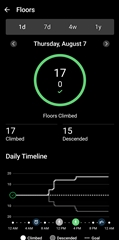Speculation. After following the quirks of how my activity appears in the Connect app for the last 8 months, I've come to the conclusion that what I'm seeing in the app is based upon data gathered from the watch that gets subsequently massaged after being bounced over to my phone and/or Garmin's servers.
I base this upon how data that I see in Connect (in more-or-less real time) gets altered slightly (and retroactively) after the watch talks to the cloud. Data is personalized, but only within certain parameters.



